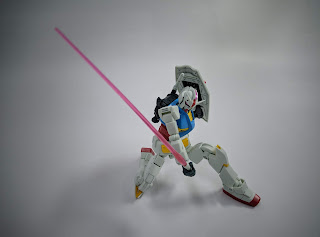OK, this one was truly different from any other kits I've ever built since I started the hobby 7 years ago. The G40 was unique in every way possible: the name, the package, the assembly, the aesthetics, the articulation, the price tag, everything. From the first glance, it's obvious that this is the iconic RX-78-2 Gundam from UC timeline, and yet, the package didn't show any model number nor timeline like a HG normally does (e.g. HGUC), and no box art, just a black box with an big embossed silver 'G40' letters printed on it. Furthermore, the price tag of 3300 yen made everybody scratched their head. Just why did a HG kit become so ridiculously expensive? Interestingly, while it should be released as a regular retail kit, but for some reason, it was sold in very limited number at stores. It looked like Bandai didn't have much confidence to sell it as a regular retail kit.
Since the first time it was announced, G40 has drawn controversy among gunpla fans across the globe. Some people praises the brand new design and articulation, while the others despised its aesthetics and price tag. Tell the truth, I was among the people who hated it in the beginning. Anyway, after learning more details and building the kit, my respect gradually became stronger towards it.
Many gunpla fans considered the design of G40 as 'ugly', especially with the curved aesthetics instead of blocky one as conventional RX mobile suit series. Anyway, the most controversial part of this kit was definitely the joints, particularly the hip joints. Due to fixed skirts of the kit, it utilized very unusual 'dropped' hip joints, which made G40 look so weird. The kit looked as it had a broken thigh. Anyway, there were big reasons behind this design. As I dug deeper into its design, I finally grasped the true concept of the design: G40 was the form of Gundam in case it's produced in real life. Surely, it betrayed the real-robot genre images many people cherish, but that 'broken thighs' are very reasonable in many real-life robot designs.
On the other hand, if there's aspects this kit excels at, then it should be the articulation. Never in my life, I've ever seen a kit so articulated as G40. It just could do any poses, from a cool poses to a absurd and ridiculous one. And while the price tag seemed so much expensive for a HG kit, the special artbook which came with it was truly worth it.
You may love it or even hate it, but with the features came with the kit IMHO, G40 was one of the best HG of 2019.
------------------------
HG Gundam G40 Industrial Design Ver.
Pros:
- The most insane articulation of gunpla you've ever seen.
- The artbook was really nice bonus (I recommend you to read it before building the kit)
- Hip joints look really weird
- Pretty expensive for a HG kit































